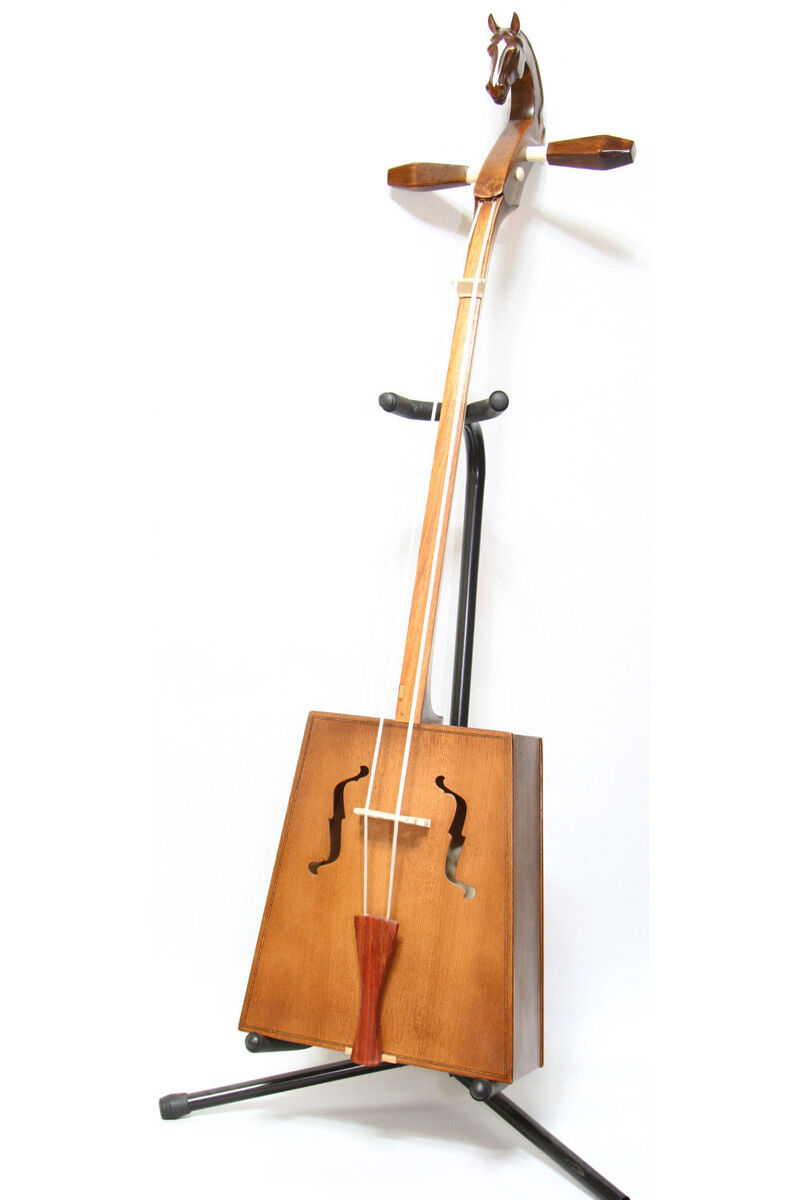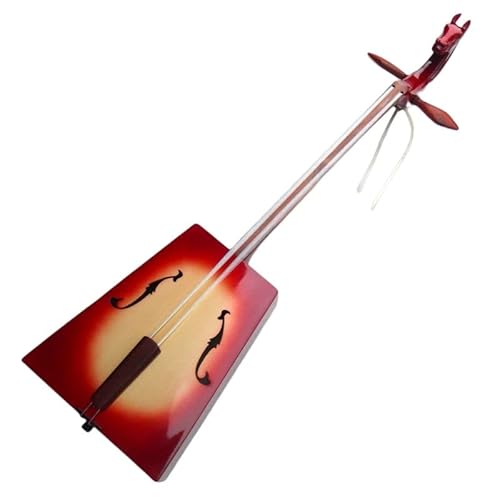Morin khuur
Bowed Instruments
Asia
Between 1001 and 1900 AD
Video
The Morin Khuur, also known as the horsehead fiddle, is a traditional Mongolian stringed instrument that holds great significance in the cultural heritage of Mongolia. This unique instrument not only serves as a musical tool but also embodies the deep connection between the Mongolian people and their nomadic lifestyle, particularly their relationship with horses.
What is the Morin Khuur?
The Morin Khuur is a two-stringed bowed instrument characterized by its distinctive shape and the horse’s head carved at the top of its long neck. It is traditionally made from wood, often birch, with a hollow trapezoidal body that contributes to its rich sound. The strings are typically made from horsehair, which not only enhances the instrument’s tonal quality but also reflects its cultural roots tied to horses. The Morin Khuur is played using a bow that is also strung with horsehair, allowing musicians to produce a wide range of sounds and melodies. The instrument is deeply intertwined with Mongolian identity and is often regarded as a symbol of the nation. Its haunting melodies evoke the vast steppes of Mongolia and are commonly associated with themes of nature, love, and the nomadic lifestyle. The Morin Khuur has been recognized by UNESCO as one of the Masterpieces of the Oral and Intangible Heritage of Humanity, highlighting its cultural importance.
History of the Morin Khuur
Origin and Development
The origins of the Morin Khuur can be traced back to Mongolia, with written records indicating its existence during the Mongol Empire in the 13th and 14th centuries. Historical texts reference string instruments adorned with horse heads, suggesting that this design has been an integral part of Mongolian culture for centuries. The instrument’s name translates directly to “horse fiddle,” emphasizing its close association with horses, which hold great significance in Mongolian society. Throughout history, the Morin Khuur has evolved alongside Mongolia’s nomadic traditions. It was traditionally used in various aspects of daily life, including rituals, celebrations, and storytelling. The music played on this instrument often accompanies khoomei (throat singing), enhancing the emotional depth of performances. Over time, the Morin Khuur has become a symbol of national pride and cultural identity for Mongolians.
Cultural Significance
The Morin Khuur’s significance extends beyond mere musicality; it represents a deep-rooted connection to Mongolia’s nomadic heritage. As nomadic tribes relied heavily on horses for transportation and livelihood, the instrument became an essential part of their cultural expression. It was used during important ceremonies such as weddings and festivals to connect participants with their ancestors and cultural roots. In contemporary Mongolia, efforts to preserve and promote traditional music have led to a resurgence of interest in the Morin Khuur. Schools incorporate its study into their curriculum to ensure that future generations appreciate this vital aspect of their heritage.
How Does the Morin Khuur Work?
The Morin Khuur operates on a simple yet effective mechanism that allows musicians to create beautiful melodies. The instrument consists of two main components: the body and the neck.
Construction
Body: The body of the Morin Khuur is trapezoidal and hollowed out to amplify sound. It is typically made from birch wood or other local materials.
Neck: The long neck is fretless and features a carved horse head at its top. This design not only adds aesthetic value but also symbolizes Mongolia’s deep connection with horses.
Strings: The instrument has two strings made from horsehair. These strings are tuned to different pitches, allowing for melodic play.
Bow: The bow used to play the Morin Khuur is also strung with horsehair. Musicians draw the bow across the strings to produce sound.
Playing Techniques
The instrument is played with the musician seated, holding the body of the Morin Khuur between the knees. The bow, traditionally made of horsehair, is drawn across the two strings, which are also made of horsehair. The strings are tuned to a fifth or fourth interval, and the player uses the left hand to press the strings lightly, producing a wide range of tones and harmonics without a fingerboard. The use of vibrato and glissando techniques is common, lending the instrument its soulful and haunting quality. One of the most unique aspects of Morin Khuur playing is its imitative technique, where players mimic the sounds of the Mongolian landscape, such as galloping horses or wind across the steppes. Skilled musicians use subtle changes in bow pressure, speed, and angle to create these effects. The Morin Khuur is often used for solo performances, accompanying traditional Mongolian throat singing (khoomei), or in ensembles to evoke the spirit of the Mongolian nomadic lifestyle.
Types of Morin Khuur
While there are variations in design based on regional styles and personal preferences, most Morin Khurs share similar characteristics. However, there are some notable distinctions:
Traditional Morin Khuur: This version adheres closely to historical designs with minimal embellishments.
Modern Variations: Contemporary versions may incorporate additional features such as extra strings or electronic amplification for versatility in modern music genres.
Regional Styles: Different regions within Mongolia may have slight variations in construction or playing style based on local traditions.
Regardless of type, each Morin Khuur retains its essential characteristics that define its role in Mongolian music.
Features of the Morin Khuur
The Morin Khuur, often referred to as the horsehead fiddle, is a traditional Mongolian bowed string instrument known for its distinctive sound and cultural significance. Its design reflects deep ties to Mongolian nomadic life, spirituality, and folklore. The instrument is characterized by its two strings, which are traditionally made from horsehair, and its resonant soundbox, crafted from wood such as spruce or pine.
A defining feature of the Morin Khuur is its carved scroll at the top of the neck, which is shaped like a horse’s head, symbolizing the importance of horses in Mongolian culture. The body is usually trapezoidal, covered with stretched animal skin, producing a rich and haunting tone. It is played with a bow strung with horsehair, which is coated in resin to create friction. The Morin Khuur produces a wide range of sounds, mimicking the galloping of horses or the vast landscapes of the Mongolian steppe. It is traditionally used in folk music, accompanying long songs (urtiin duu), epic storytelling, and ceremonial rituals. Its unique timbre has also made it a favorite in contemporary world music. Recognized as a symbol of Mongolian heritage, the Morin Khuur was inscribed on UNESCO’s Representative List of the Intangible Cultural Heritage of Humanity in 2008.
Music Composed for the Morin Khuur
The music produced by the Morin Khuur encompasses a wide range of styles deeply rooted in Mongolian tradition:
Traditional Music
Music composed with the Morin Khuur often reflects the vastness of the Mongolian steppe, imitating the sounds of nature, such as the galloping of horses, flowing rivers, or the call of birds. This connection to nature makes its compositions uniquely expressive and evocative. The Morin Khuur is commonly used in traditional Mongolian music, including long song (urtiin duu), where its sustained and melodic tones enhance the slow, meditative vocal lines. It also plays a crucial role in epic storytelling, providing an emotional backdrop to narratives about heroes, legends, and historical events. In folk dances, its rhythmic capabilities are highlighted, complementing the dynamic movements of the performers.
Contemporary Adaptations
In modern times, the Morin Khuur has been incorporated into contemporary and fusion music, blending its hauntingly beautiful sound with genres like classical, jazz, and even rock. Whether in traditional or modern compositions, the Morin Khuur’s ability to evoke a sense of place and emotion ensures its lasting significance in Mongolian and global music traditions.
Significance of the Morin Khuur
The significance of the Morin Khuur transcends its role as a musical instrument; it embodies cultural identity and heritage for many Mongolians:
Cultural Identity
As a national symbol, the Morin Khuur represents Mongolia’s rich history and traditions. It serves as a reminder of nomadic lifestyles and communal values inherent in Mongolian society.
UNESCO Recognition
In 2008, UNESCO recognized the Morin Khuur as part of its Representative List of Intangible Cultural Heritage. This acknowledgment emphasizes its importance as a cultural treasure deserving of preservation for future generations.
Educational Role
The integration of Morin Khuur education into schools reflects efforts to maintain cultural continuity. Students learn not only how to play but also about their heritage through music education programs focused on traditional instruments.
Global Influence
As interest in world music grows globally, musicians outside Mongolia have begun incorporating elements of Morin Khuur into their compositions. This cross-cultural exchange fosters an appreciation for Mongolian traditions while promoting artistic innovation.
It stands as an enduring symbol of Mongolia’s rich cultural tapestry. Its unique design, historical significance, and emotional resonance make it more than just an instrument; it is a vital link between traditions and contemporary expressions. As efforts continue to preserve this remarkable piece of heritage through education and performance initiatives worldwide, we can expect the beautiful horsehead fiddle to resonate for generations to come.
FAQ
What materials are used to make the Morin Khuur?
The Morin Khuur is traditionally made of wood for the body, horsehair for the bow, and leather or fabric for decoration. The strings are also crafted from horsehair, symbolizing Mongolia's equestrian culture.
How is the Morin Khuur played?
The Morin Khuur is played with a bow, producing a deep, resonant sound. Players use various bowing and fingering techniques to create melodies, often imitating the sounds of nature and animals.
What cultural significance does the Morin Khuur hold?
The Morin Khuur is a symbol of Mongolia's nomadic heritage. It is used in rituals, storytelling, and celebrations, embodying the spiritual connection between humans, animals, and nature.
 Links
Links
References
Other Instrument
Categories



















